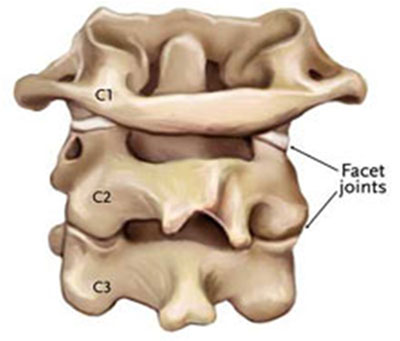
Facet Joint Pain
 Facet joints is also known as zygapophyseal, apophyseal, or Z-joint.Facet joint are synovial joints between the vertebrae of spine. There are two facet joints (left and right) in each spinal motion segment.
Facet joints is also known as zygapophyseal, apophyseal, or Z-joint.Facet joint are synovial joints between the vertebrae of spine. There are two facet joints (left and right) in each spinal motion segment.
Function -
Each pair of facet joints limits movement of that spinal motion segment. Each section of spine has facet joints.
Cervical facet joints (neck)
Thoracic facet joints (mid back)
Lumbar facet joints (low back)
Cause -
1. Joint motion can stiffen - known as hypomobility.
Locked facet joint- Simple movements such as a mild twist, awkward movement
Facet joint arthritis
Degenerative facet joint osteophytes (bone spurs)
Joint capsule scarring ( thickening or shortening)
Muscle spasm
2. Joint motion can become excessive - known as hypermobility.
Fracture
Dislocation
Overstretched ligaments
Disease that destroys the joints. E.g. Rheumatoid arthritis.
Symptom -
1. A neck facet joint will cause neck pain and potentially shoulder or upper arm pain.
2. A back facet joint injury will cause low back pain and potentially pain referred into buttock or thigh
3. When a facet joint locks, Patient may not be able to move in the direction away from where its lock
4. Muscle spasm
5. Pain on the opposite side to the locked facet joint
6. Decreased movement
7. Pain or difficulty stretching
8. Weak stability muscles that are failing to control movement of spine
Diagnosis -
Hands on examination from a physiotherapist
X-rays, MRIs and CT scan are unable to detect a locked facet joint.
Physiotherapy Treatment-
Painless joint releasing technique
Strengthening Exercises
stabilization program for hypermobile facet joint

